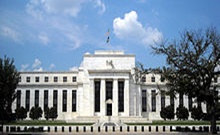US Fed extends quantitative easing, keeps interest rate low
31 Oct 2013
The Federal Open Market Committee (FOMC) of the US Federal Reserve on Wednesday decided to continue with its highly accommodative monetary policy and to keep interest rate at its present lows as long as unemployment remained above 6.5 per cent and inflation remained below 2 per cent.
 At the end of a two-day meeting, the FOMC decided to keep the interest rate for federal funds at 0 to 0.25 per cent and to continue purchasing $85 billion worth of bonds every month, including $40 billion in agency mortgage-backed securities and $45 billion in longer-term Treasury securities.
At the end of a two-day meeting, the FOMC decided to keep the interest rate for federal funds at 0 to 0.25 per cent and to continue purchasing $85 billion worth of bonds every month, including $40 billion in agency mortgage-backed securities and $45 billion in longer-term Treasury securities.
The FOMC said the exceptionally low range for the federal funds rate will be appropriate at least as long as the unemployment rate remains above 6.5 per cent.
The Fed projects US inflation over the next one or two years to be not more than a half a percentage point above its 2 per cent longer-run goal.
The Fed will maintain its existing policy of reinvesting principal payments from its holdings of agency debt and agency mortgage-backed securities in agency mortgage-backed securities while rolling over maturing Treasury securities at auction.
''Taken together, these actions should maintain downward pressure on longer-term interest rates, support mortgage markets, and help to make broader financial conditions more accommodative, which in turn should promote a stronger economic recovery and help to ensure that inflation, over time, is at the rate most consistent with the committee's dual mandate,'' a Fed release said.
And, despite weak data and uncertainties caused by the partial government shutdown, the Fed seemed to believe that the economy is improving.
The overwhelming view was that while household spending and business fixed investment advanced, the recovery in the housing sector slowed somewhat in recent months.
The FOMC cited a fiscal policy constraint to economic growth. Except for the energy prices, the committee said inflation has been running below its longer-term objective.
But, at least one member of the FOMC, Esther L George, was concerned that the continued high level of monetary accommodation increased the risks of future economic and financial imbalances and, over time, could cause an increase in long-term inflation expectations.
The Fed statement also did not make any reference to the 16-day government shutdown, which economists say has slowed growth this quarter.
Some analysts had earlier suggested that the Fed might be prepared to slow its bond purchases by early next year - sooner than some have assumed.
However, the Congress' budget fight seems to have clouded the Fed's timetable for tapering its bond purchases (See: US government begins shutdown; 1 mn workers may lose pay).
Without a budget deal by 15 January, another shutdown is possible.
Congress must also raise the government's debt ceiling after 7 February to avoid a financial market catastrophe (See: US Congress passes bill to end debt crisis; shutdown ends).






















